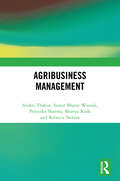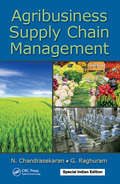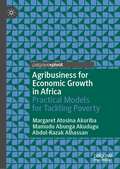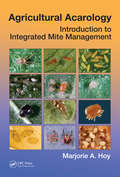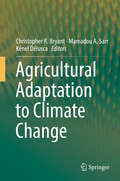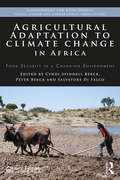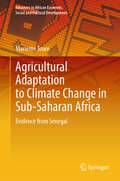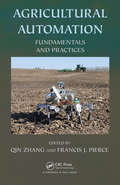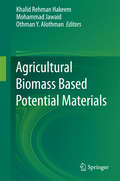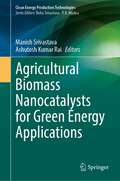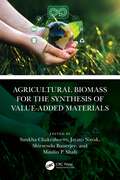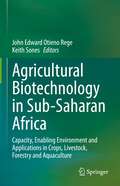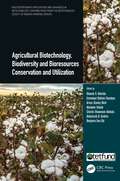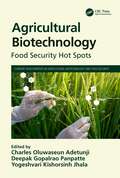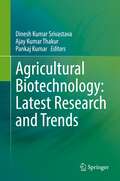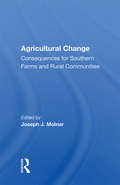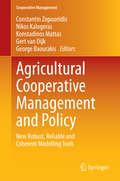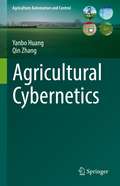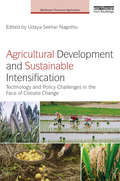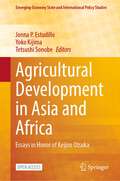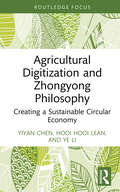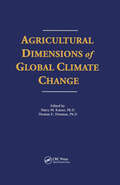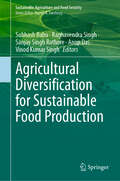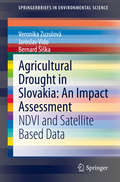- Table View
- List View
Agribusiness Management
by Priyanka Sharma Srishti Thakur Sumit Bharat Wasnik Bhavya Kush Rebecca NelsonThis book serves as a guide to understanding the intricacies and challenges of managing agribusiness enterprises in the modern era. It covers the fundamentals of agribusiness management and discusses the trends and emerging issues. Through real-world case studies and practical examples, this book aims to bridge the gap between theory and practice, enabling the reader to apply their knowledge in diverse agribusiness contexts.Print edition not for sale in South Asia (India, Sri Lanka, Nepal, Bangladesh, Pakistan and Bhutan)
Agribusiness Supply Chain Management
by N. Chandrasekaran G. RaghuramThe agribusiness supply chain includes a number of processes such as supply management, production management, and demand management to customers through a competitive distribution channel. Each step of the way can be plagued with issues such as diversity of production and demand, bulkiness of produce, perishability, and seasonality. Highlighting t
Agribusiness for Economic Growth in Africa: Practical Models for Tackling Poverty (Palgrave Advances in Bioeconomy: Economics and Policies)
by Abdul-Razak Alhassan Mamudu Abunga Akudugu Margaret Atosina AkuribaThis book provides exclusive information on how agribusinesses could act as the springboard for inclusive economic growth critical for socioeconomic transformation of Africa. It is a must read for academics, practitioners, policymakers, students, and all those interested in the application of practical models capable of tackling the endemic poverty situation in Africa using agribusiness as the launchpad. The book emphasizes the urgent need for robust and inward-looking enabling policy frameworks to help remove existing constraints on agro-industrialization and encourage investments. Thus, the book sets the agenda for the right combination of agricultural, industrial, and trade policies critical in promoting sustainable agricultural commodity value chains and food systems for inclusive growth and poverty reduction. Written in a simple, plain, and accessible language devoid of technical jargons, the book makes an interesting read for even the non-expert and is a valuable reference material for academic and practical training of students and practitioners.
Agricultural Acarology: Introduction to Integrated Mite Management
by Marjorie A. HoyWritten by a globally prominent entomologist, Agricultural Acarology: Introduction to Integrated Mite Management provides tools for developing integrated mite management programs for agriculture, including management of plant-feeding mites, mites attacking bees and livestock, and stored products. Emphasizing the biology, ecology, behavior, and diverse methods of controlling mites, this book provides an overview of the management of agriculturally important mites using all available Integrated Pest Management (IPM) tools, including biological control, cultural practices, host-plant resistance, and pesticides.Agricultural Acarology prepares agricultural managers to identify, manage, and contribute to the field of integrated mite management. An accompanying downloadable resource contains numerous color photographs of mites and the damage they cause, and PDFs of key publications.
Agricultural Adaptation to Climate Change
by Christopher R. Bryant Mamadou A. Sarr Kénel DéluscaThis book deals with one of the major challenges facing human society and its governments, climate change and variability. The principal objective of the book is to explore how agricultural production through the actions primarily of farmers, including peasant farmers, adapt to these changing circumstances, what the limitations of adaptation are, how the process of adaptation varies between different territories (e. g. developed countries versus developing countries), and what are or can be the most effective roles for actors other than the farmers, including different levels of government and non-governmental organizations (NGOs) such as professional associations of farmers and community organizations. The principal argument is threefold: 1) while there are significant differences between territories and countries in terms of the capacity of farmers (and the other actors) to engage in capacity building to be able to adapt effectively to climate change and variability, 2) the critical roles are those played out by the farmers themselves, but that 3) other actors can play an important role in accompanying farmers in their adaptation process, providing relevant and strategic information, counseling them and facilitating networking and meetings when appropriate. This effectively means that without engaging in the local adaptation processes governments can really only play effective roles by working with other actors at the local and regional levels. When it occurs, it can be very effective, but when it does not, farmers are left to their own devices (and even then, many are able to use their own creativity and local knowledge to survive and continue to develop). Essentially therefore, the secondary argument that is followed throughout the book is that adaptation is essentially a social process that requires an understanding of social processes and dynamics in each farming community and territory. It involves an understanding, for instance, of information diffusion processes in the different farming communities and territories, which provides a set of tools to promote and facilitate the adoption process in the context of adaptation to climate change and variability.
Agricultural Adaptation to Climate Change in Africa: Food Security in a Changing Environment (Environment for Development)
by Peter Berck Cyndi Spindell Berck Salvatore Di FalcoA changing climate is likely to have a drastic impact on crop yields in Africa. The purpose of this book is to document the effects of climate change on agriculture in Africa and to discuss strategies for adaptation to hotter weather and less predictable rainfall. These strategies include promoting opportunities for farmers to adopt technologies that produce optimal results in terms of crop yield and income under local agro-ecological and socioeconomic conditions. The focus is on sub-Saharan Africa, an area that is already affected by changing patterns of heat and rainfall. Because of the high prevalence of subsistence farming, food insecurity, and extreme poverty in this region, there is a great need for practical adaptation strategies. The book includes empirical research in Ethiopia, Kenya, South Africa, Tanzania, and other Sub-Saharan countries, and the conclusion summarizes policy-relevant findings from the chapters. It is aimed at advanced students, researchers, extension and development practitioners, and officials of government agencies, NGOs, and funding agencies. It also will provide supplementary reading for courses in environment and development and in agricultural economics.
Agricultural Adaptation to Climate Change in Sub-Saharan Africa: Evidence from Senegal (Advances in African Economic, Social and Political Development)
by Marieme ToureIn the light of the impact of extreme weather events, declining agricultural productivity and child malnutrition in sub-Saharan Africa, this book explores the potential for sustainable agriculture to better respond to climate-related threats. By presenting a case study of Senegal, the author offers insights into the impact of climate change on long-term crop production, food security, and child malnutrition. Furthermore, the study sheds new light on the financialization of agricultural production and foreign direct investments, discusses policy instruments and adaptation strategies for implementing sustainable agriculture, and highlights the role of green financing instruments to enable the harmonization of private financing and green infrastructure. It will appeal to scholars of agricultural and development economics, and anyone interested in climate risk mitigation strategies and sustainable agriculture to achieve a green transition in sub-Saharan Africa.
Agricultural Automation: Fundamentals and Practices
by Qin Zhang Francis J. PierceAgricultural automation is the core technology for computer-aided agricultural production management and implementation. An integration of equipment, infotronics, and precision farming technologies, it creates viable solutions for challenges facing the food, fiber, feed, and fuel needs of the human race now and into the future. Agricultural Automat
Agricultural Biomass Based Potential Materials
by Khalid Rehman Hakeem Mohammad Jawaid Othman Y. AlothmanAgricultural biomass is abundant worldwide and it can be considered as alternative source of renewable and sustainable materials which can be used as potential materials for different applications. Despite this enormous production of agricultural biomass, only a small fraction of the total biomass is utilized for different applications. Industry must be prepared to take advantage of the situation and utilize the available biomass in the best possible manner. Agricultural biomass such as natural fibres has been successfully investigated as a great potential to be used as a renewable and sustainable materials for the production of composite materials. Natural fibres offer excellent specific properties and have potential as outstanding reinforcing fillers in the matrix and can be used as an alternative material for biocomposites, hybrid composites, pulp, and paper industries. Natural fibre based polymer composites made of jute, oil palm, flex, hemp, kenaf have a low market cost, attractive with respect to global sustainability and find increasing commercial use in different applications. Agricultural biomass based composites find applications in a number of fields viz. , automotive industry and construction industry. Future research on agricultural biomass-natural fibre based composites should not only be limited to its automotive applications but can be explored for its application in aircraft components, construction industry, rural housing and biomedical applications. In this book we will cover the chemical, physical, thermal, electrical, and biodegradability properties of agricultural biomass based composite materials and its different potential applications. The main goal of this volume is to familiarize researchers, scientists and engineers with the unique research opportunities and potentials of agricultural biomass based materials. Up-to-date information on alternative biomass utilization Academic and industry leaders discuss unique properties of biomass based composite materials Direct application of agricultural biomass materials as sustainable and renewable alternatives
Agricultural Biomass Nanocatalysts for Green Energy Applications (Clean Energy Production Technologies)
by Manish Srivastava Ashutosh Kumar RaiThe book discusses the various sustainable approaches to combine agrowaste and nanomaterials into catalysts or nanocatalysts with the objective of enhancing biofuel production. It explores the practical sustainability of agronanocatalysts in bioenergy production at a mass scale, while also addressing the existing challenges and proposes sustainable remedies to overcome these limitations. Additionally, the book dives into the cost considerations, recognizing it as a major concern for the widespread utility of catalysts, and explores viable commercial applications in this context.Nanomaterials continue to attract attention in the field of proteins and enzymes due to their versatile physicochemical properties and potential. They offer opportunities to enhance various biofuel production processes by serving as catalysts in the reaction medium. For instance, studies have highlighted the significant improvements in cellulase enzyme production, stability, pretreatment of lignocellulosic biomass, and enzymatic hydrolysis efficiency achieved through the utilization of nanomaterials. The impact of nanomaterials on fermentative hydrogen production has also been documented. While the application of nanomaterials in biofuel production processes has been reported in the literature, there remains a need to focus on the type of nanomaterials, their synthesis, and their specific effects on important process parameters. Addressing and evaluating these factors is crucial to effectively improve and streamline biofuel production processes using nanomaterials. The book serves as a comprehensive introduction to nanomaterials and nanotechnology in biofuel production, catering to the needs of researchers, academicians and students.
Agricultural Biomass for the Synthesis of Value-Added Materials
by Maulin P. Shah Sankha Chakrabortty Jayato Nayak Shirsendu BanerjeeThis book is a comprehensive guide to bioconversion approaches based on microorganisms and enzymes for the valorization of underused wastes of diverse categories to produce new products. Optimized conditions for microbial and enzymatic valorization are discussed, along with related biotechnological considerations, environmental considerations, bioprocess development, obstacles, and future outlooks. Biofuels, bioenergy, and other platform chemicals are only some of the products that can be produced through this book's explanation of the microbiological processes involved in the bioconversion and valorization of wastes.
Agricultural Biotechnology in Sub-Saharan Africa: Capacity, Enabling Environment and Applications in Crops, Livestock, Forestry and Aquaculture
by John Edward Otieno Rege Keith SonesThis book offers a comprehensive analysis of the application level for various agricultural biotechnologies across Sub-Saharan Africa. The authors examine the capacity available as well as the enabling environment, including policy and investments, for facilitating agricultural biotechnology development and use in the region. For each Sub-Saharan country, the status of biotechnology application is assessed in four major sectors; Crops, Livestock, Forestry and Aquaculture. Examples such as the number and requisite skill levels of trained personnel, biosafety frameworks and public awareness are surfaced in these chapters. This work also discusses the impact of push-pull factors on research, training and food security and identifies opportunities for investment in biotechnology and local agribusiness.Development partners, policy makers, agricultural consultants as well as scientists and private sector investors with an interest in biotechnology initiatives in Sub-Saharan Africa will find this collection an important account to identify key gaps in capacity and policy, as well as priority areas going forward. The volume highlights ways to develop technology and increase agricultural production capacity through international cooperation and inclusive economic growth, making it a valuable practice guide in line with the UN Sustainable Development Goals, in particular SDG 2 Zero Hunger and SDG 8 Decent Work and Economic Growth. Clear case studies round off the reading experience.
Agricultural Biotechnology, Biodiversity and Bioresources Conservation and Utilization (Multidisciplinary Applications and Advances in Biotechnology)
by Charles Oluwaseun Adetunji Abdulrazak B. Ibrahim Benjamin Ewa Ubi Olawole O. Obembe Abubakar Gidado Emmanuel Olufemi Ekundayo Arinze Stanley OkoliThis book covers a range of important topics on crop and animal genetics, breeding and genomics, as well as biodiversity and genetic resources conservation and utilization reflecting three thematic sections of working groups of the Biotechnology Society of Nigeria. The topics range from agricultural biotechnology, including genetically modified organisms and gene-editing for agronomically important traits in tropical crops, to Nigeria’s mega biodiversity and genetic resources conservation. This book will engender a deeper understanding of underpinning mechanisms, technologies, processes and science–policy nexus that has placed Nigeria as a leader in biotechnology in Africa. The book will be useful reference material for scientists and researchers working in the fields of food and agricultural biotechnology, bioinformatics, plant and animal genetics, breeding and genomics, genetic resources conservation and enhancement. Emphasizes recent advances in biotechnologies that could ameliorate the high-level global food and nutrition insecurity through plant and animal genetics, breeding, as well as genomics Provides detailed information towards harnessing indigenous bioresources for food and nutrition security and climate change adaptation Introduces new frontiers in the area of genomics, most especially their relevant applications in crop and animal breeding Reviews biotechniques that could enhance plant genetic resources conservation and utilization Discusses current biotechnological approaches to exploit genetic resources including the development of synthetic hexaploid wheat (SHW) for crop adaptation to the increasingly changing global climate
Agricultural Biotechnology: Food Security Hot Spots (Current Developments in Agricultural Biotechnology and Food Security)
by Charles Oluwaseun Adetunji Deepak Gopalrao Panpatte Yogeshvari Kishorsinh JhalaThis book presents strategies and techniques highlighting the sustainability and application of microbial and agricultural biotechnologies to ensure food production and security. This book includes different aspects of applications of Artificial Intelligence in agricultural systems, genetic engineering, human health and climate change, recombinant DNA technology, metabolic engineering and so forth. Post-harvest extension of food commodities, environmental detoxification, proteomics, metabolomics, genomics, bioinformatics and metagenomic analysis are discussed as well. Features: Reviews technological advances in microbial biotechnology for sustainable agriculture using Artificial Intelligence and molecular biology approach. Provides information on the fusion between microbial biotechnology and agriculture. Specifies the influence of climate changes on livestock, agriculture and environment. Discusses sustainable agriculture for food security and poverty alleviation. Explores current biotechnology advances in food and agriculture sectors for sustainable crop production. This book is aimed at researchers and graduate students in agriculture, food engineering, metabolic engineering and bioengineering.
Agricultural Biotechnology: Latest Research and Trends
by Pankaj Kumar Ajay Kumar Thakur Dinesh Kumar SrivastavaThis book caters to the need of researchers working in the ever-evolving field of agricultural biotechnology. It discusses and provides in-depth information about latest advancements happening in this field. The book discusses evolution of plant tissue culture techniques, development of doubled haploids technology, role of recombinant-DNA technology in crop improvement. It also provides an insight into the global status of genetically modified crops, use of RNAi technology and mi-RNAs in plant improvement. Chapters are also dedicated for different branches of ‘omics’ science including genomics, bioinformatics, proteomics, metabolomics and phenomics along with the use of molecular markers in tagging and mapping of various genes/QTLs of agronomic importance. This book also covers the role of enzymes and microbes in agriculture in productivity enhancement. It is of interest to teachers, researchers of biotechnology and agriculture scientists. Also the book serves as additional reading material for undergraduate and postgraduate students of biotechnology, agriculture, horticulture, forestry, ecology, soil science, and environmental sciences. National and international biotechnologists and agricultural scientists will also find this to be a useful read.
Agricultural Change: Consequences For Southern Farms And Rural Communities
by Joseph J. MolnarThis book examines the impact of the rise and fall of new commodities, production technologies, and shifting government policies on individuals and farm families in the rural South and the interrelationship between agricultural change and community change.
Agricultural Cooperative Management and Policy: New Robust, Reliable and Coherent Modelling Tools (Cooperative Management)
by Constantin Zopounidis Konstadinos Mattas Nikos Kalogeras Gert Dijk George BaourakisThis book focuses on the use of farm level, micro- and macro-data of cooperative systems and networks in developing new robust, reliable and coherent modeling tools for agricultural and environmental policy analysis. The efficacy of public intervention on agriculture is largely determined by the existence of reliable information on the effects of policy options and market developments on farmers' production decisions and in particular, on key issues such as levels of agricultural and non-agricultural output, land use and incomes, use of natural resources, sustainable-centric management, structural change and the viability of family farms. Over the last years, several methods and analytical tools have been developed for policy analysis using various sets of data. Such methods have been based on integrated approaches in an effort to investigate the above key issues and have thus attempted to offer a powerful environment for decision making, particularly in an era of radical change for both agriculture and the wider economy.
Agricultural Cybernetics (Agriculture Automation and Control)
by Qin Zhang Yanbo HuangAgricultural systems are uniquely complex systems, given that agricultural systems are parts of natural and ecological systems. Those aspects bring in a substantial degree of uncertainty in system operation. Also, impact factors, such as weather factors, are critical in agricultural systems but these factors are uncontrollable in system management. Modern agriculture has been evolving through precision agriculture beginning in the late 1980s and biotechnological innovations in the early 2000s. Precision agriculture implements site-specific crop production management by integrating agricultural mechanization and information technology in geographic information system (GIS), global navigation satellite system (GNSS), and remote sensing. Now, precision agriculture is set to evolve into smart agriculture with advanced systematization, informatization, intelligence and automation. From precision agriculture to smart agriculture, there is a substantial amount of specific control and communication problems that have been investigated and will continue to be studied.In this book, the core ideas and methods from control problems in agricultural production systems are extracted, and a system view of agricultural production is formulated for the analysis and design of management strategies to control and optimize agricultural production systems while exploiting the intrinsic feedback information-exchanging mechanisms. On this basis, the theoretical framework of agricultural cybernetics is established to predict and control the behavior of agricultural production systems through control theory.
Agricultural Development and Sustainable Intensification: Technology and Policy Challenges in the Face of Climate Change (Earthscan Food and Agriculture)
by Udaya Sekhar NagothuSustainable Intensification (SI) has recently emerged as a key concept for agricultural development, recognising that yields must increase to feed a growing world population, but it must be achieved without damage to the environment, on finite land resources and while preserving social and natural capital. It also recognises that all initiatives must cope with the challenges of climate change to agricultural production, food security and livelihoods. This multidisciplinary book presents state-of-the-art reviews of current SI approaches to promote major food crops, challenges and advances made in technology, and the institutional and policy measures necessary to overcome the constraints faced by smallholder farmers. Adressing the UN's Sustainable Development Goal 2, the various chapters based on evidence and experiences of reputed researchers show how these innovations, if properly nurtured and implemented, can make a difference to food and nutrition security outcomes. Case studies from around the world are included, with a particular emphasis on Asia and Sub-Saharan Africa. The focus is not only on scientific aspects such as climate-smart agriculture, agroecology and improving input use efficiency and management, but also on institutional and policy challenges that must be met to increase the net societal benefits of sustainable agricultural intensification. The book is aimed at advanced students and researchers in sustainable agriculture and policy, development practitioners, policy makers and non-governmental and farmer organisations.
Agricultural Development in Asia and Africa: Essays in Honor of Keijiro Otsuka (Emerging-Economy State and International Policy Studies)
by Tetsushi Sonobe Jonna P. Estudillo Yoko KijimaThis Open Access book explores the multifaceted nature of agricultural and rural development in Asia and examines the extent to which the Asian experience is being replicated in contemporary Africa. This volume compiles the works of top scholars who provided analyses and evidences from household-level surveys collected for many years in several parts of Asia and Africa. The most important finding presented in this book is that African agricultural development has evolved following the pathways of Asian agricultural development. The common pathways are borrowed technology from abroad and adaptive research in rice farming; secured property rights on natural resources; adoption of ICTs; investments in human capital, including training; and launching of the high-value agriculture. In both continents, agricultural development started in the crop sector, which had a strong tendency to induce the dynamic development of other sectors in rural areas.
Agricultural Digitization and Zhongyong Philosophy: Creating a Sustainable Circular Economy (Routledge Focus on Environment and Sustainability)
by Ye Li Yiyan Chen Hooi Hooi LeanThis interdisciplinary book combines digital technology with Eastern philosophy to examine how the concept of Zhongyong in Confucianism can be used to coordinate digital technology with sustainable agriculture. Zhongyong comes from the connotation of moderate and sustainable in ancient Chinese culture. It is with this concept in mind that this book presents a novel collaboration between philosophy and computer technology to explain how Zhongyong can play an important part in realizing agricultural digitization within a circular economy in order to help solve the current food crisis. The book examines two popular, yet contradictory, digital technologies—blockchain and the green data center. It showcases how the use of traditional Chinese Zhongyong can promote the decentralization of blockchain and the centralization of the green data center and explains the advantages of using both technologies simultaneously. The book puts forward a digital circular agricultural framework that embeds both blockchain and the green data center through an actual case study. While this book specifically focuses on agriculture, it also provides readers with a new perspective for thinking further on how to break down the disciplinary barriers between the social sciences and natural sciences. This book will be of great interest to students and scholars of agriculture, digital technologies, circular economy, sustainable development, and Eastern philosophy.
Agricultural Dimensions of Global Climate Change
by Harry Kaiser Thomas DrennenThis important book, written by recognized leaders in their fields, discusses agricultural dimensions of global climate change. Research and policy issues are covered and a multidisciplinary view of global climate change and agriculture is presented. Major sections cover the contribution of agriculture to greenhouse gas (GHG) emissions (including an investigation as to whether monitoring and verification of such emissions would work) and the impact of global climate change on agriculture. The book examines such important issues as global food availability, distributional effects between developing and developed countries, agricultural adaptation possibilities, and whether CO2 enrichment will benefit agriculture. A unique feature of this publication is that it addresses communication difficulties between researchers and policy makers and suggests solutions.
Agricultural Diversification for Sustainable Food Production (Sustainability Sciences in Asia and Africa)
by Anup Das Vinod Kumar Singh Subhash Babu Raghavendra Singh Sanjay Singh RathoreThis book discusses agricultural diversification, nutritional security and environmental sustainability. It helps to address the multipronged challenges of nutritional security while preserving the dwindling natural resources in the current fluctuating climate conditions. Energy-intensive, conventional agricultural production systems accelerate environmental footprints, resource mining, biodiversity losses, and human health problems and reduce soil functionality. Diversified farming can potentially enhance yield, food security, and climate change buffering as it helps to achieve advanced food security by efficient resource use and profit maximization. This book covers the challenges faced during the adoption of diversified farming and opportunities to enhanced food production and minimize the environmental footprints. This book is useful for academicians, researchers, ecologists, environmentalists, students, capacity builders, and policymakers to have in-depth knowledge of this complex and diverse field. This book also helps in devising a road map for policy planning and advancement of existing knowledge for various stakeholders working in this field.
Agricultural Drones: A Peaceful Pursuit
by K. R. KrishnaAgricultural drones are expected to revolutionize the way we conduct agronomic procedures and maintain natural vegetation on earth. This book explores the increasing importance of the role of aerial robots in managing agricultural farms and natural resources. Agricultural Drones: A Peaceful Pursuit provides a wealth of information on drone usage in agriculture. The book discusses the advanced sensors and imaging capabilities of drones that give farmers new ways to increase yields and reduce crop damage. An introductory chapter provides historical data, with details about various models of drones as well as the most recent and popular agricultural drones in usage. The book goes onto look at such topics as the use of drones for soil fertility, production agronomy, irrigation, weed control, pest and disease control, grain yield forecasting, and economic advantages from drone use. This timely and useful volume will be a valuable resource for faculty, agricultural extension officers, and farmers and farm consultancy agencies. This book would also serve as an excellent textbook for students in agriculture, engineering, geography, etc. Key features: • outlines the advantages of using drones in agriculture, such as for the management of soil fertility, the study of natural resources and vegetation, the maintenance of adequate irrigation, and the control of weeds and pests • covers the economic advantages of using drones in agriculture • examines the regulatory aspects of agricultural drones • provides actual examples of drone usage in agriculture
Agricultural Drought in Slovakia: NDVI and Satellite Based Data (SpringerBriefs in Environmental Science)
by Veronika Zuzulová Jaroslav Vido Bernard ŠiškaThis book gives an insight into the evaluation of drought in Slovakia and provides an assessment of Normalized Difference Vegetation Index (NDVI) as a method suitable for an evaluation of drought in agricultural land. Dry seasons in the time series from 1960 to 2014 were determined according to the monthly Palmer Drought Severity Index (PDSI). The field research was carried out on 12 sites including western Slovakia, Prešov, Trnava and Nitra regions. Data collected from satellite imagery, climate data analyses and drought indices was analysed to determine the value of NDVI as an evaluation tool.
